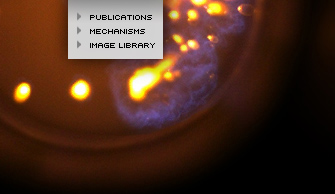

![]()
Design of improved gas-sensing and other advanced materials
Understanding ignition and reaction kinetics
New diagnostics
New experimental facilitiesDesign of improved gas-sensing and other advanced materials: Accurate control of particle microstructure and composition is a major obstacle in enabling combustion synthesis (CS) technologies for the production of advanced materials. Understanding the fundamental mechanisms important in these synthesis systems will enhance the ability to design robust synthesis methods, to optimize synthesis conditions and to realize the potential of nanostructured materials.
At UM, we have developed a unique approach for CS of nanosized particles, including nanocomposites, using a hybrid diffusion flame system (Hall et al. , 2004; Miller et al. , 2005; Bakrania et al. , 2006a; Bakrania et al. , 2006b). Our methods to the investigation and production of powders via CS represents an original and exciting new avenue of research, where we can control the particle composition and microstructure by varying the relative physical and chemical reaction rates important in the synthesis environment. The materials systems we study include tin dioxide (SnO2), the most important active material in solid-state gas sensing, with applications ranging from industrial safety to food quality control.
We have demonstrated a single step solvent-free process to create SnO2 nanoparticles using a hybrid diffusion flame system (Hall et al. , 2004). The hybrid method greatly expands the range of control March 5, 2015gle crystalline structures (i.e. nanorods), encapsulated morphologies (i.e. core/mantel structures), and additive composition (including good integration of the additives within the SnO2 architecture and the versatility to use a wide variety of metals as additives) (Miller et al. , 2005; Bakrania et al. , 2006b). This work represents the first flame synthesis of nanorod SnO2 crystal structures of which we are aware. The long SnO2 crystalline structures produced by CS can have significant implications with respect to gas sensor performance. Nanorod and nanobelt materials have been demonstrated as having part per billion sensitivities to target gases. However, the synthesis methods used for these are complex catalyst-assisted recipes involving multiple fabrication steps. CS allows one-step processing for both doped and undoped nanorod structures. The high production rates and high quality of CS materials greatly increases scalability compared to alternate synthesis methods as well.
Understanding ignition and reaction kinetics: Many combustion systems are limited in reaction progress by chemical kinetics, particularly lean premixed strategies which are the focus of numerous advanced combustion technologies. Consequently, accurate knowledge of the rate coefficients important in combustions systems is vital for increasing thermal efficiencies, reducing pollutant emissions, and improving safety and combustion performance.
Low-temperature combustion strategies offer potential to dramatically increase device efficiencies while simultaneously reducing pollutant emissions. Lean equivalence ratios and premixed operation are promising means of achieving these improvements, and there are significant efforts to apply such strategies to modern engine design. When combustion temperatures are reduced, chemical kinetics often become rate limiting in terms of the rate of reaction progress, particularly in premixed systems. Yet there are few experimental data at the pressures and conditions directly relevant to the advanced power generation strategies under consideration. Such data are vital to understanding the operational limits for combustor design, quantifying characteristic chemical reaction times, and developing and validating accurate reaction mechanisms.
At the UM, we have developed a powerful approach to studying ignition chemistry using a unique rapid compression facility (RCF) (Donovan et al. , 2004). Ignition experiments provide direct insight into the reactions controlling radical pool growth and fuel oxidation pathways and quantify ignition behavior at realistic combustion conditions. RCF studies have the advantage of long test times that allow the effects of a broad range of mixtures and conditions on ignition delay time to be examined. In addition, the fuel/air mixtures can be investigated at realistic levels of dilution using air, and the results are not complicated by uncertainties in mixture preparation and transport properties.
New diagnostics: High-temperature, chemically reacting, and potentially multi-phase combustion systems are difficult to interrogate accurately with conventional laboratory diagnostics, such as thermocouples and gas-sampling probes. Therefore, new and improved tools and methods are needed for advancing our understanding of advanced and practical combustion systems.
We have developed methods to apply absolute, quantitative diagnostics for OH and H2O measurements to multi-phase combustion systems at high-temperatures and pressures using absorption of narrow-line laser emission. These diagnostics have been successfully demonstrated in high particle density flows (> 4x1011 particles/cm3, Torek et al., 2002; Donovan et al., 2003), and to study particle nucleation - the least well understood phase of particle formation and growth in flames (Donovan et al., 2005). Using such an approach, we have documented the first observation of two-stage ignition in a silane combustion system (Donovan et al., 2005).
New experimental facilities: The canonical laboratory systems used to study combustion phenomena provide the means to isolate the chemistry and physics of interest. However, there is need to understand how the phenomena translate to more complex combustion environments. Hence, we have recently established a new engine research facility where optical access is utilized to conduct fundamental studies of advanced engine technologies.
The primary objective of the new optical research engine facility at the UM is to provide improved understanding of the chemical and physical mechanisms that are important in advanced engine systems, including expanded HCCI and other low-temperature combustion strategies. Research conducted with the optical engine research facility compliments that of the UM RCF, expanding to experiments with multiple cycles in a flexible, production-based engine configuration. Specifically, we have characterized the similarities and differences in the ignition phenomena observed during HCCI lean operating conditions for multiple classes of fuels, including reference (indolene), pump (pump gasoline) and chemical surrogate (iso-octane) fuels (Zigler et al.; 2006a), and how these ignition data compare to results of RCF which isolate chemical kinetics. We have also successfully demonstrated that spark-assisted combustion can be used to stabilize HCCI combustion and for extending lean operating limits (Zigler et al. , 2006b).
maintained by: Scott Wagnon, swagnon@umich.edu
last updated: March 5, 2015